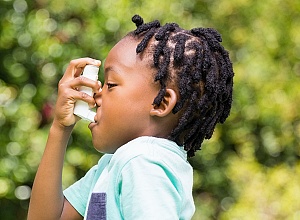Asthma is the most common chronic illness of childhood. The prevalence is rising and the mortality and morbidity from asthma in South Africa are unacceptably high. The South African Childhood Asthma Working Group has issued guidelines for the diagnosis and treatment of asthma, just published in the South African Medical Journal.
“It is important to make a correct diagnosis based, most importantly, on the clinical history and supported by investigations,” says the article titled “Summary of childhood asthma guidelines, 2021: A consensus document”.
“The appropriate drug and device must be chosen to achieve good asthma control. Patients must be followed up regularly and their asthma control must be assessed. The treatment can then be adjusted according to the level of control.
“The COVID-19 pandemic has placed new challenges on the care of our asthmatics. Asthma education and adherence are important components of management of the condition.”
The guidelines document was produced by nine experts from the universities of the Witwatersrand, Pretoria, Stellenbosch, KwaZulu-Natal and Cape Town, and Life Westville Hospital in Durban, on behalf of the South African Childhood Asthma Working Group (SACAWG), a sub-committee of the Allergy Society of South Africa.
SACAWG first published guidelines for the management of chronic asthma in children and adolescents in 1992, followed by revisions in 1994, 2000 and 2009, the article says. In the interim, there have been a number of key changes in the diagnostic criteria (particularly in young children, assessment of asthma control, management principles, new drugs, new drug-delivery devices and assessment of asthma control and risk).
“This new updated consensus statement attempts to provide an update on the management of childhood asthma, incorporating new information and including a section on COVID-19. The full document appears on the Allergy Society of South Africa website (see link below).
Study details
Summary of childhood asthma guidelines, 2021: A consensus document
AI Manjra, A van Niekerk, DA White, S Kling, HJ Zar, R Masekela, M Levin, FE Kritzinger and RJ Green
On behalf of the South African Childhood Asthma Working Group (SACAWG), a sub-committee of the Allergy Society of South Africa.
Author affiliations: Charlotte Maxeke Johannesburg Academic Hospital at the University of the Witwatersrand; Faculty of Health Sciences at the University of Pretoria; Tygerberg Hospital and Faculty of Medicine and Health Sciences at Stellenbosch University; Nelson Mandela School of Medicine at the University of KwaZulu-Natal; MRC Unit on Child and Adolescent Health and the Faculty of Health Sciences at the University of Cape Town; and Life Westville Hospital in Durban.
Published by the South African Medical Journal of May 2021. Volume 111, Number 5.
Asthma diagnosis
Asthma is the most common chronic respiratory disorder in childhood. The prevalence of asthma in childhood is high and is rising. Asthma is underdiagnosed and undertreated.
Asthma should be diagnosed in children who present with episodes of variable expiratory airflow limitation. It remains a largely clinical diagnosis, which should be supported by lung function testing in school-aged children.
The symptoms may include episodic wheeze (due to bronchoconstriction), shortness of breath, difficult or laboured breathing, chest tightness and reduced activity with or without cough. The intensity varies over time and symptoms improve after correct use of a rapid-acting inhaled bronchodilator.
The symptoms are not specific to asthma, and other conditions may mimic the condition. Chronic airway inflammation and variable expiratory airflow limitation define asthma. We propose the following four steps to guide the clinician.
Summary of the changes
- In children <6 years of age with recurrent wheezing triggered by respiratory tract infections and no wheezing between infections, we recommend starting a short course (7 – 10 days) of daily ICS at the onset of a respiratory tract infection with an as-needed short-acting beta-2 agonist (SABA) for quick-relief therapy compared with as-needed SABA for quick-relief therapy only.
- In children 6 – 11 years of age we recommend as-needed SABA and a short course (7 – 10 days) of ICS at the start of an upper-respiratory tract infection or daily low-dose ICS.
- In children aged ≥6 years with moderate to severe persistent asthma, we recommend ICS-formoterol in a single inhaler as daily controller and reliever therapy compared with either higher-dose ICS as daily controller therapy and SABA for quick-relief or same-dose ICS-LABA as daily controller therapy and SABA for quick-relief therapy.
SAMJ article – Summary of childhood asthma guidelines, 2021: A consensus document
Allergy Society of South Africa website
SEE ALSO FROM THE MEDICALBRIEF ARCHIVES
Omega-3 fatty acids may prevent asthma in some children
Guidelines for treating paediatric asthma
Over-diagnosis of asthma by GPs is common
Link between persistent childhood asthma and COPD

